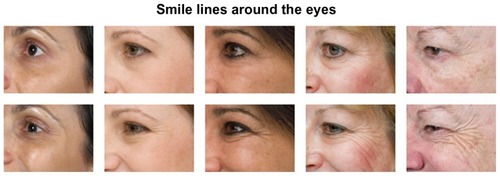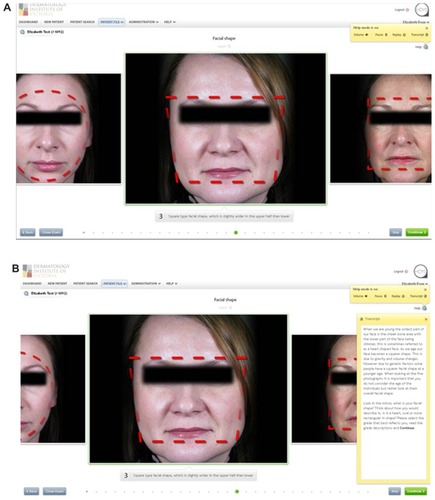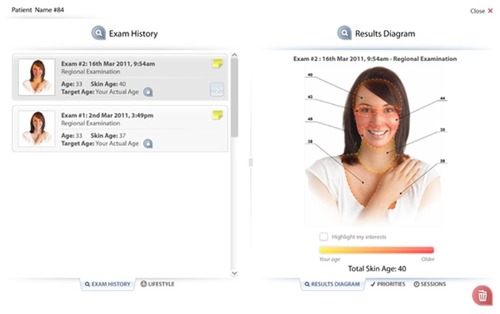Abstract
Background
Objective and subjective scales estimating improvement in both clinical studies and clinical practice are becoming more mainstream. However, the use of a system to analyze improvement in aging with a multiplicity of treatments would be useful. The purpose of this study was to use a recently developed educative and patient self-assessment program (“Home of Younger Skin”, HOYS) for assessment of the effect of facial treatment with neurotoxins and filling agents in terms of decreasing apparent age.
Methods
Four patients underwent facial treatments with neurotoxins and dermal fillers by an experienced blinded physician and were assessed twice utilizing an age analysis program (HOYS), once before and then 6 weeks after completion of treatment.
Results
The four patients showed an average reduction in apparent facial age of 7.5 years. The individual “regions” differed in their reductions. The upper face showed a decline of 13.5 years, the periorbital region 9.25 years, the mid face 4.5 years, and the lower face 12.25 years.
Conclusion
Use of this previously validated self-assessment program may prove to be a useful measure of patient-reported improvement with treatment.
Introduction
Skin aging in females is generally not a uniform process. Many women have distinct areas (subregions) of the face, chest, neck, or hands that age well, some in keeping with their chronological age, and others making them appear older than they are. The HOYS (“Home of Younger Skin”) is a newly validated patient education and treatment planning software program, developed with the objective of creating an individualized and reproducible consultation. This program enables patients to make informed treatment decisions in collaboration with their health care practitioner.Citation1
Whilst other scales have been widely reported and used in research and clinical practice,Citation2–Citation13 the HOYS program not only assesses skin ages in a number of regions, but develops treatment plans allowing patients and staff to track the progress of the treatments delivered. The program has two different audiences, ie, the patient (and their aesthetic physician) and the clinical investigator. This program is specifically designed for patient self-evaluation and education regarding age-related changes encountered by women aged 20–65 years via a representative series of digital images.Citation1 These images characterize age-related changes to the skin surface, ie, the effects of muscle movement and volume shifts in a total of 35 defined areas (subregions) of the human face. Each of these 35 subregions is depicted by five images from a “typical” patient at age 25, 35, 45, 55 or 65 years, reflecting five grades of aging or “severity” of the particular feature, presented in a Likert scale. The first program profile was designed for Caucasian females.
During administration of the program, patients view their image in a mirror while using a web-based application of the program. They select the image that most closely represents their own appearance for the particular subregion under examination. Examples of the scales used in the regions most examined are shown in –. The program is automated, with a help function consisting of audiovisual and written prompts allowing patients to navigate at their own pace (). At the conclusion of the program, the grades identified by the patient as closest to their own appearance generate a report detailing the “skin age” for each of the seven regions, underpinned by the 35 subregions ().
Figure 1 Region 1 (forehead and brows) showing glabellar frown lines in relaxed and contracted state.
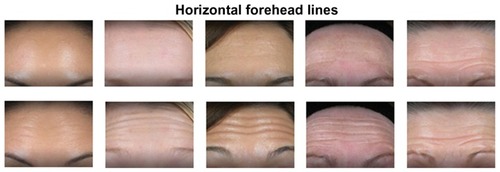
Table 1 Seven geographical regions and constitutent subregions of the HOYS program
These seven regions encompass the upper face, which is divided into two regions (forehead and temples and the periorbital region), the mid face, the perioral/lower face, and the extrafacial regions of the neck, décolletage, and hands. A total skin age score is also generated, which is a composite of these seven regions (). The program creates a prioritization list of the subregions based on the degree of age divergence or “grade” assigned by the patient for each of these regions. This is measured against what is expected for a woman of the same chronological age and is defined by the program utilizing a proprietary algorithm (). This forms the basis for the clinical treatment plan used by the physician in consultation with the patient ().
Figure 7 Screen showing the results scores listed by severity and patient prioritization in first step of developing a treatment plan.

Figure 8 Page showing treatment priorities identified by patient and clinician and session creation.

The program generates a total skin score as well as skin scores for the seven constituent regions detailed above and keeps a record of subregion selections and how these may change over time or with treatment. This opens up another potential use for this program in the field of clinical research. Completing the program assessment prior to treatment intervention and then repeating this assessment post-treatment captures a quantitative measure of outcome. This can be used as a means to assess comparative efficacy following administration of different aesthetic treatments in the same patient. In addition, this may be used objectively in patient assessment or by a blinded or unblinded observer.
The photonumeric Likert scales representing the 35 subregions used in this program have been validatedCitation14 and are used in this paper to identify self-reported improvement seen in patients after facial treatment. These involve volume-enhancing injections of hyaluronic acid as well as botulinum toxin for facial and neck muscle relaxation.
Materials and methods
In a small study, the software program was used by patients to self-assess their appearance against the set of validated scales. The patients self-assessed these areas before and after treatment by an injector blinded to the HOYS examination, and its results and suggestions. The blinded injector was given the ability to correct the patients with botulinum toxin and hyaluronic acid optimally in two sessions. This software also involves treatment planning and part of the study was to assess its predictive power compared with a blinded, experienced injector.
Four eligible female patients with an average age of 52 years (individual ages 39, 43, 57, and 69 years) were studied, and two program analyses were performed prior and 6 weeks following treatment. A second treatment was performed, if required, 4–6 weeks after the first. The final program analysis occurred 6 weeks after optimal correction. All patients received treatment to the forehead and brows, and periorbital, mid, and lower face areas. In this study, there was no surgical treatment or treatment to the skin surface such as lasers, intense pulsed light, or chemical peels, so the possibility of further self-assessed improvement in skin age exists with the addition of these treatments.
Many of the subregions examined by this program are those influenced by fillers and neurotoxins, but many other subregions are not. The subregions not influenced are predominantly in the mid face region, such as pores, facial telangiectases, pigmentation, age spots, and sunspots, and require agents other than hyaluronic acid or botulinum toxin. Because no change would be probable in these uninvolved subregions, there is an expected dilution effect on the regional score in this study. Certain regions normally examined by the program, such as the chest and hands, were not treated nor included in this study. No skin care advice or lifestyle suggestions, usually part of the program’s advice, were included in this study.
All patients fully consented to the procedures performed and to the intent of examination using the program. The treatments were planned to proceed with or without examination using the program, with the program acting only to capture data, and not to direct treatment.
Results
The decrease in average full-face skin age was found to be 7.5 years, but certain areas did improve more than this average. The forehead and brow region showed a decline in self-reported skin age of 13.5 years, the periorbital region 9.25 years, the mid face 4.5 years, and the lower face 12.75 years ( and ). Individual patient scores before and after treatments are shown in . In individual patients, the treatment of some regions seemed to make an extraordinary change of nearly two decades in the lower face of the oldest patient and upper face of the youngest patient (). Only one patient registered an increase in age with treatment, showing an increase of 2 years after treatment of the mid face. The blinded injectors’ decisions regarding therapy were all predicted by the program.
Figure 9 A 57-year-old patient showing self-assessed full facial age decrease of 8 years, with focal areas of upper face showing a decrease of 17 years and lower face showing improvement of 15 years after having botulinum toxin and hyaluronic acid fillers.
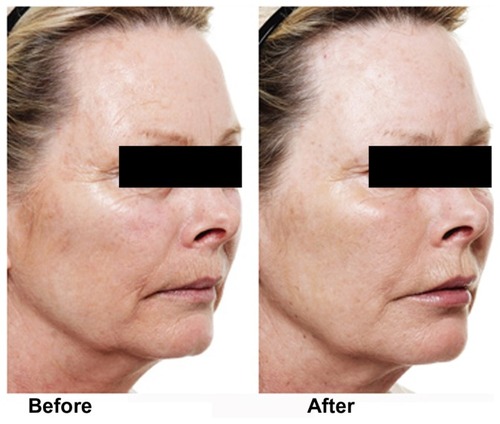
Figure 10 A 69-year-old patient showing a full facial decrease of 14 years in self-assessed age, with the upper face decreasing by 16 years and the lower face decreasing by 19 years following intervention with botulinum toxin and hyaluronic acid fillers in these regions.
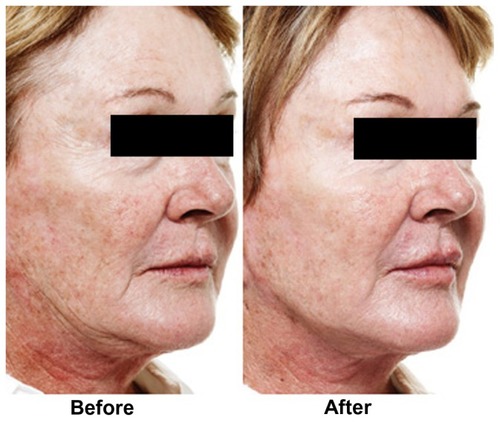
Table 2 Skin age of patients by region and overall before and after treatment
Discussion
As we age, there are subtle clues to this aging which are recognizable to ourselves and to others. We all age similarly but subtly, and different parts of us age at different rates. We all have a stock of genetic material, and from then on, we age by intrinsic and extrinsic means. Intrinsic facial aging is more about subtle volume changes that slowly show their clues decade by decade, requiring change of personal identification such as passport or driving license at these intervals. Facial recognition software is extraordinary but may struggle with recognition over many decades of life. Changes in bone, dentition, and soft tissue volume also contribute to intrinsic changes which appear through the years in a genetically preordained way. Correction of diet and adjustment of aspects such as hormonal status may allow a slowing of this aging.Citation15 Extrinsic changes relate more to surface changes of environmentally damaged skin, although in essence share similar pathways to intrinsic aging processes, but appear as a sharper, more exaggerated version.Citation16 In between these two types of changes, and intersecting like a Venn diagram, are the effects of movement on the aging process. Movement is primarily for registering our emotional responses to others in a socialized world. These responses represent annoyance, surprise, amusement, happiness, anger, and many other emotions.Citation17 It is their appearance at rest that seems to point to our age. The way we use our muscles is probably a genetically programmed aspect with recurrent movement or expression, even at a young age, suggesting where fixed wrinkles will likely follow. These wrinkles may begin to stamp themselves as volume depletes over time, and become fixed if the skin is sun-damaged and can no longer deal with recurrent movement. To examine multiple treatments and their effects on the appearance of patients in a meaningful way, we require a tool allowing a reproducible method of studying the total effect of those treatments. The HOYS program was devised to provide patient education and empowerment to achieve optimal therapeutic outcomes as the patient self-assesses their appearance section by section. When a patient is considering combining rejuvenation strategies, it is useful to have a patient-reported outcome measure such as HOYS to follow their improvement as well as to indicate to both the patient and practitioner their expected improvement in self-perceived skin age with therapy.
Disclosure
GJ Goodman is the owner of the HOYS program. S Roberts reports no conflicts of interest in this work.
References
- WilliamsLMAldermanJECussellGPatient’s self-evaluation of two education programs for age-related skin changes in the face: a prospective, randomized, controlled studyClin Cosmet Investig Dermatol20114149159
- CarruthersACarruthersJHardasBA validated grading scale for forehead linesDermatol Surg200834Suppl 2S155S16019021673
- CarruthersACarruthersJHardasBA validated lip fullness grading scaleDermatol Surg200834Suppl 2S161S16619021674
- CarruthersACarruthersJHardasBA validated grading scale for crow’s feetDermatol Surg200834Suppl 2S173S17819021676
- CarruthersACarruthersJHardasBA validated brow positioning grading scaleDermatol Surg200834Suppl 2S150S15419021672
- BuchnerLVamvakiasGRomDValidation of a photonumeric wrinkle assessment scale for assessing nasolabial fold wrinklesPlast Reconstr Surg201012659660120679841
- KimEJReeckJBMaasCSA validated rating scale for hyperkinetic facial linesArch Facial Plast Surg2004625325615262720
- DayDJLittlerCMSwiftRWGottliebSThe wrinkle severity rating scale: a validation studyAm J Clin Dermatol20045495214979743
- RossiANkengneAStamatasGBertinCDevelopment and validation of a photonumeric grading scale for assessing lip volume and thicknessJ Eur Acad Dermatol Venereol20112552353120825530
- HundTAscherBRzanyBSmile Study GroupReproducibility of two four-point clinical severity scores for lateral canthal lines (crow’s feet)Dermatol Surg2006321256126017034375
- ValetFEzzedineKMalvyDMaryJYGuinotCAssessing the reliability of four severity scales depicting skin ageing featuresBr J Dermatol200916115315819416243
- CarruthersACarruthersJHardasBA validated hand grading scaleDermatol Surg200834Suppl 2S179S18319021677
- CarruthersACarruthersJHardasBA validated grading scale for marionette linesDermatol Surg200834Suppl 2S167S17219021675
- GoodmanGJHalsteadMBRogersJDA software program designed to educate patients on age-related skin changes of facial and exposed extrafacial regions: the results of a validation studyClin Cosmet Investig Dermatol2012512331
- PontiusATSmithPWAn antiaging and regenerative medicine approach to optimal skin healthFacial Plast Surg201127293421246454
- KohlESteinbauerJLandthalerMSzeimiesRMSkin ageingJ Eur Acad Dermatol Venereol20112587388421261751
- AlamMBarrettKCHodappRMArndtKABotulinum toxin and the facial feedback hypothesis: can looking better make you feel happier?J Am Acad Dermatol2008581061107218485989
